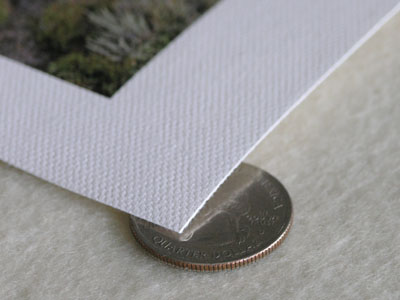About Canvas Prints |
|
Canvas prints are made on the finest heavyweight matte white cotton-poly blend canvas without optical brighteners, ensuring stable and lifelike color rendition that won't fade prematurely. The edges of the image are copied, flipped, and added back to the image to create "gallery wrap" borders that mirror the edges of the image. The printed canvas is then stretched over 1.5 inch thick heavy-duty wooden bars to produce a dimensional artwork having the entire image on its face, with the mirrored edges wrapped around the sides of the stretcher bars. In many environments, these gallery-wrapped canvas prints stand out without further embellishment, creating a bold, contemporary look that demands attention. Optional 2.25 inch deep satin black wood floater frames add a thin, elegant accent around the art that works well in more formal settings. Matte canvas prints look particularly stunning without any protective coating - their complete absence of reflected glare or shine gives them an amazing appearance of depth and immediacy from any viewing position. Visitors to Better Light's print gallery often remark that they feel like they could just walk into these large, glare-free prints, although we advise against trying this. Uncoated canvas prints should still provide excellent print life without significant fading, but their ink-receptive surfaces can still absorb dirt or liquids that might cause discoloration, and the matte printed surface is more susceptible to scuffing or similar damage. To maintain their impressive impact, uncoated canvas prints should be hung where they can be admired without being subject to touching, scraping, dirt, or moisture. These prints can optionally be coated with a layer of clear varnish to seal their ink-receptive surfaces and provide some protection against physical damage. Coating the printed canvas invariably adds some sheen to its surface, producing reflections that reduce the clarity of darker areas and make the print look flatter. Coated canvas prints are slightly more robust than uncoated prints, but they should still be hung in a protected environment like other fine art. |
|
|



